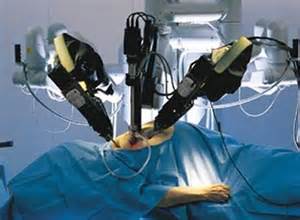 Medical historians disagree on which was the first robot for medical use and when the first robot-assisted surgery took place. Some say the first was the “Arthrobot”, which was developed and used for the first time in Vancouver, BC, Canada in 1983. Others say the first documented use of a robot to assist with a surgical procedure occurred in 1985 when the PUMA 560 was used with CT scan to place a needle for a neurosurgical biopsy. They can agree on one thing about its history, though; the robotic system offered greater precision and successful outcomes. This led to the first robot-assisted laparoscopic procedure in 1987.
Medical historians disagree on which was the first robot for medical use and when the first robot-assisted surgery took place. Some say the first was the “Arthrobot”, which was developed and used for the first time in Vancouver, BC, Canada in 1983. Others say the first documented use of a robot to assist with a surgical procedure occurred in 1985 when the PUMA 560 was used with CT scan to place a needle for a neurosurgical biopsy. They can agree on one thing about its history, though; the robotic system offered greater precision and successful outcomes. This led to the first robot-assisted laparoscopic procedure in 1987.
Experts continued to improve on these surgery-enhancing robotic machines over the next 20 years, and in 2000, the da Vinci robot became the first complete robotic surgical system to be approved by the FDA for general laparoscopic surgery. Since then, the list of procedures performed laparoscopically with robot assistance has grown at a pace consistent with improvements in technology and the technical skill of surgeons. Now daVinci is used frequently around the world for performing bariatric and gastrointestinal surgery, cardiothoracic surgery, ear, nose and throat surgery, gynecological surgery, and even pediatric surgery, among others.
Surgeons, patients, and insurance companies agree that minimally invasive, robot-assisted surgery offers great benefits over traditional open surgery. Incisions are smaller, so procedures leave little to no scars. The risk of infection is less, hospital stays are shorter, if necessary at all, and convalescence is significantly reduced. Many studies have shown that laparoscopic procedures result in decreased hospital stays, a quicker return to the workforce, decreased pain, and better postoperative immune function.
If you think you might be a candidate for robotic surgery, schedule a consultation with Dr. Johnson, a Las Vegas board-certified robotic surgeon.

 MATTHEW JOHNSON, MD Trauma Surgeon, General Surgeon &
MATTHEW JOHNSON, MD Trauma Surgeon, General Surgeon &
